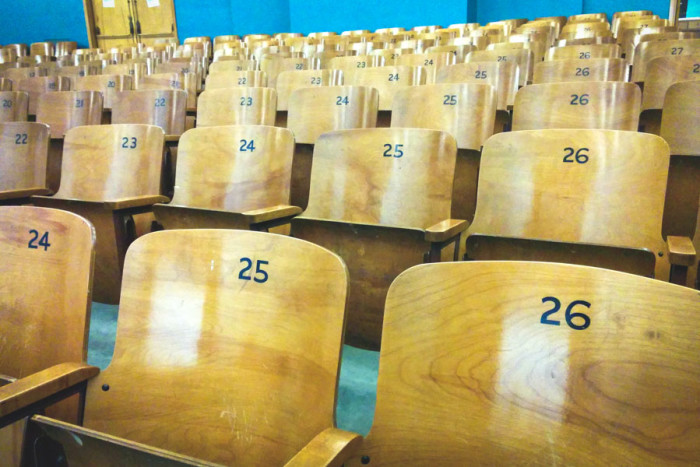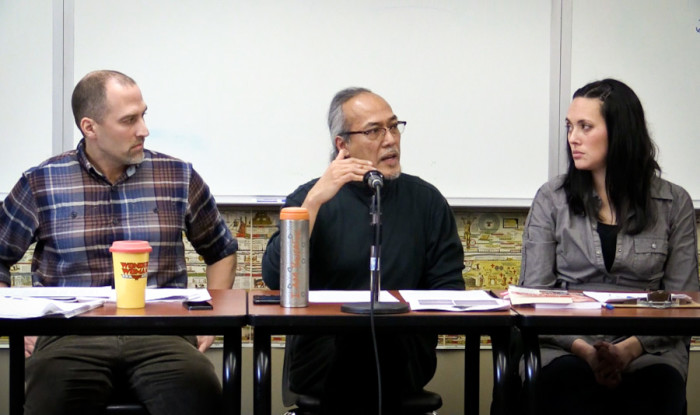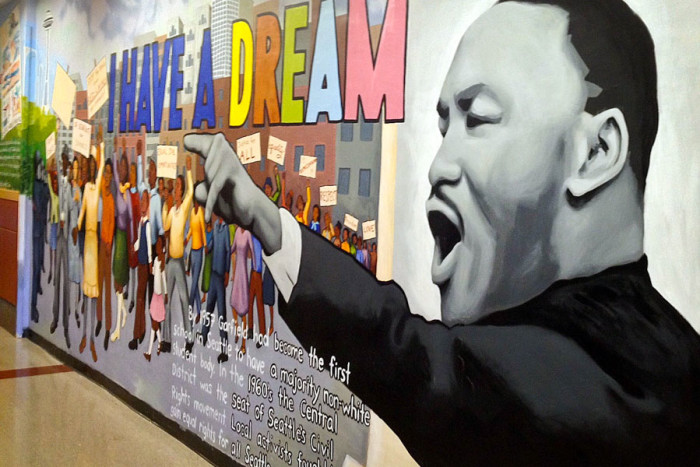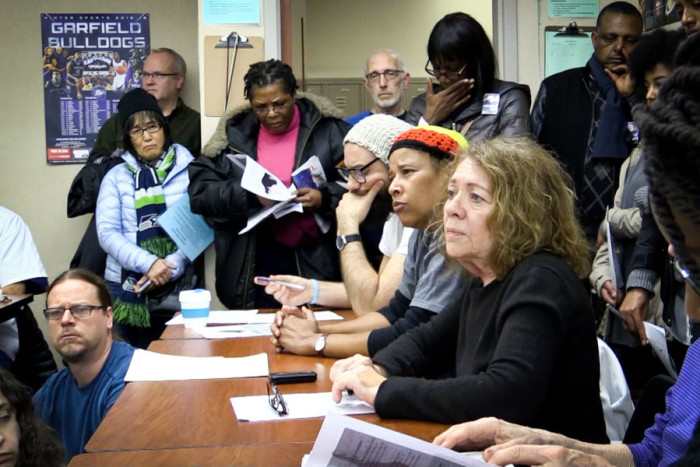
In 2012 the family of a white student in Jon Greenberg’s race and social justice class at The Center School filed a complaint against him with the Seattle school district.
The family said the class made their child uncomfortable, and pressed for a colorblind approach to teaching about race.
Greenberg was investigated by Seattle Public Schools. Despite having taught the popular unit for nine years without complaint, the district found him guilty of intimidating students and punished him with a transfer out of the school — which effectively killed his curriculum.
Then last year after two decades at Middle College (an alternative school focusing on social justice pedagogy for the underserved, mostly students of color) co-founding educator Rogelio (Roger) Rigor was suddenly pushed out of his job on a technicality. Rogelio is the eighth Middle College teacher of color displaced by the district — a move that is wreaking slow but steady death upon the school’s progressive pedagogy.
This Martin Luther King Jr. Day at Garfield High School I had the honor of joining Jon and Rogelio for a public workshop: “The Need For Increased Social Justice Teaching — And The Obstacles Such Education Faces”.
We spoke to a full house, standing room only.
The message? That the injustices meted out to Greenberg, Rigor and their students are not isolated incidents. They are symptomatic of a nationwide push to privatize education, standardize “magic bullet” curricula, and ultimately destroy social justice learning in schools.

In 2010 Arizona made national headlines when white leaders passed House Bill 2281 which wiped out a highly successful Mexican American Studies (MAS) program in Tucson Unified School District. A 2011 Southern Poverty Law Center study gave 35 states an “F” grade in their teaching of core information about the civil rights movement.
Meanwhile, a recent comprehensive survey of U.S. school districts found our typical student takes 112 mandated standardized tests between pre-kindergarten and 12th grade.
More and more students are impacted by the corporate chokehold on transformative education.
But it’s not always easy to get a clear picture of what’s happening.
The smothering of justice learning is often cloak-and-dagger, clandestine, covert. Opportunities for students to be enlightened are swiftly swept away before we even knew they existed, or denied before we even knew they were an option.
Greenberg, Rigor and I addressed four critical questions Monday morning:
What is social justice teaching?
“The way I teach social justice is to make sure students see the big picture” said Rigor. “Everything is connected, nothing is ever isolated.”
As a math and science teacher, for instance, Rogelio taught students about climate change, resource allocation, and how countries are impacted by the “paradigm of profit.”
Likewise Greenberg built his curriculum on three criteria, teaching about history and events that: (a) target a group of people, (b) cause suffering, and (c) are unfair.
“Social justice teaching is trying to change the status quo,” he said, pointing out that it’s as much about advocating for students outside of the classroom as it is about curriculum.
To me, it’s about celebrating the triumphs and centering the struggles of marginalized voices. As a field interviewer I have spoken with over 150 people about their experiences with discrimination. Most of what they describe are stories barely seen in media, such as what it’s like to be a homeless man of color or grow up a Cambodian refugee in Seattle.
We need to expand our vision, our empathy, our criticality; ask more questions; know realities rather than artifice; empower and liberate.
But why social justice teaching?
Because we do not live in a just society. Nor have we ever.
Currently 3,000 children in Seattle Public Schools are homeless.
Between 80-90% of LGBTQ youth are bullied in school.
The number of forcible rapes reported at colleges has increased 49 percent.
The same year Jon Greenberg was investigated, Seattle Public Schools itself came under federal investigation for disproportionate disciplining of Black students.
Unsurprising then that Rigor said many students come to Middle College with a lot of anger.
“But,” he said sadly, “the anger is directed to themselves.”
So why social justice teaching? Because it works.
Rigor said it was amazing to see those same students transformed by social justice learning.
“They begin to see that it is not them,” he explained, “There is a re-channeling of this anger towards a system that has been institutionalized towards them.”
“Social justice teaching decenters those dominant perspectives and makes sure there’s space for other perspectives that get erased, minimized, altered, distorted,” Greenberg agreed. “That’s why it’s so powerful.”

How is social justice teaching being challenged?
Recalling the details of his displacement, Rigor said the story spun by those in power is that Middle College is still here and its social justice curriculum in place. But really the essence of the school is gone.
“This term ‘social justice’ is being spewed about as if it’s really the kind of social justice we truly need,” he warned, “I will argue that…[SPS] are taking off the edges of what it truly means.”
Jon Greenberg called out white people: the white family that filed a complaint against him here in Seattle; the white Arizona politician who lead the charge to take down MAS; the white family who complained about and erased a diversity class at Delavan-Darien High School in Wisconsin; the white students who filed a complaint of intimidation against a Minneapolis professor for discussing race in their communications class.
“Are we at the stage now where just the topic of white privilege constitutes ‘intimidation’ to white people?” he asked. “This is happening all over.”
There is ample evidence that ethnic studies has measurable positive impacts for students, and yet it is still being pushed out of our schools.
American schools are more segregated now than they were in 1968. The real question at a time when wealth is increasingly concentrated in the hands of a few is “whose interests does it serve not to teach about social justice?”
So what can we do to save it?
How can the public extend a much-needed helping hand, throw off the suffocating corporate mire, and pull social justice teaching back to center?
“I think bottom line is we need to start mobilizing,” Rigor put forward bluntly, “making sure the district here at least in Seattle knows what we need.”

Greenberg called for mandating ethnic studies particularly in our secondary school classrooms. That is, the same kind of ethnic studies that grew out of the Civil Rights Movement because it contributed to growing self-awareness and radicalization of people of color.
To me, it’s important that people work on themselves first.
You can go through the motions and check off your list of social-justice-things-to-do, but if you don’t have that consciousness and haven’t raised your awareness . . . it won’t work.
Miseducation is a weapon. As Filipino historian Renato Constantino has said, “The most effective means of subjugating a people is to capture their minds.”
That’s precisely why we need to save social justice teaching. We all need restorative learning to cure our historical amnesia and collective forgetting. Because knowledge is change and knowing accurate history, is a form of resistance.
More resources:
- You can watch the full video of the workshop here.
- Jon Greenberg’s website Citizenship and Social Justice — named after his class — describes what happened in his case and includes many resources for social justice teaching.
- Greenberg additionally recommends the newly launched Facebook group, For Racial Justice In Seattle Schools.
- Finally, please visit the also new Seattle Social Justice Education Advocates website (of which Rigor is a member).


Yes!
Thank god this is being brought to the public’s attention. We need education that teaches our youth the harsh realities of America. It is ironic how the public school system teaches that we have the First Amendment but not how to use it, or how to reason when to use it. This country’s well-being is not measured by GDP, that tells us nothing about our emotional, spiritual, intellectual, or physical factors. GDP tells us nothing about being a human being. In the same vein, the results of our decisions are more than economic in nature, especially when there are social harms that are considered to be externalities at stake. Development and the gentrification that often follows displaces many people of color or those who have low income status, destroying social networks, limiting access to vital resources, and reshaping our communities. We need to have education that helps our youth who are soon to become our community leaders to be able to sort out these types of issues, and to recognize and respect the humanity of each person, each human being impacted by our decisions.
Our country is rife with problems that are destroying lives, families and communities. We have to prepare our next generation with the skills they need to effectively address these problems. Social justice teaching is one way to accomplish this goal.